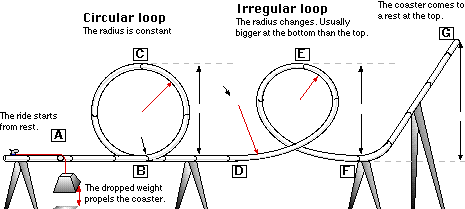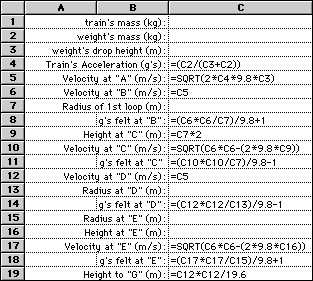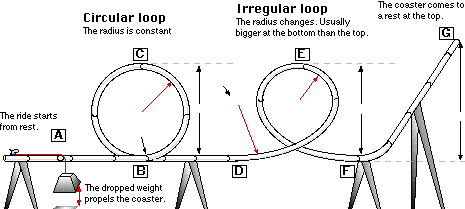Loop Physiology Exercise Using a
Spreadsheet
The activity on the following page is good for a quick
introduction to loop design. It is appropriate for students who lacks
the necessary math skills. It could also be used as a quick overview
to loop design.
The first page is to be used as a reference. The second page is where
the calculations are done on a spreadsheet.
This diagram is to be used in conjunction with the spreadsheet below
and the questions on the following page.


Below is the spreadsheet and its formulae for the
"Investigating the Loop Using a
Spreadsheet" handout. The text on the left hand side is in the
"B" column. The "B" column is right justified.
The Spreadsheets formulae

Investigating the
Loop Using a Spreadsheet
Questions:
1 A 5500 kg coaster train is propelled by a 120,000 kg weight that is
dropped 20.0 m to the ground. The first loop has a radius of 25
m.
a) How many g's are felt by the rider as he enters the first
loop?
b) How fast is the rider traveling as he travels over the top of the
first loop?
c) How many g's are felt by the rider as he travels over the top of
the first loop?
d) Make the radius at the bottom of the irregular loop 25 m. What
must the radius at the top of the second loop be if its height is 42
meters?
2 A 5500 kg coaster train is propelled by a 91,000 kg weight that is
dropped 25.0 m to the ground.
a) What must the radius of the first loop be so that a rider feels 2
g's as she enters the loop?
b) What must the radius of the second loop be so that a rider feels 2
g's as she enters the loop?
c) How high and what radius must the irregular loop be so that a
rider feels the same g's at the top and bottom?
3 Design a roller coaster where the rider feels 2.9 to 3.1 g's at
every acceleration except at the top of the first loop.
Enter your numbers at the appropriate locations on the diagram
below.

4 In terms of g's felt by a rider, what are the benefits of using an
irregular loop versus a circular loop?
If you use or find this page useful or have any
comments, please contact the author so maybe he'll do more.
Author: Tony Wayne
"ROLLER COASTER PHYSICS" TABLE
OF CONTENTS ... PHYSICS PAVILION TABLE OF
CONTENTS
<--PREVIOUS
SECTION ... NEXT SECTION -->